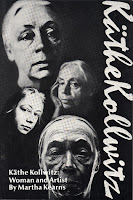 |
| Self-portrait |
Kathe (1867-1945) is regarded as one of the most important artists of the twentieth century, and as a remarkable woman who created timeless art works against the backdrop of a life of great sorrow, hardship and heartache.
 |
| Bread |
Kathe was born in in Konigsberg, East Prussia (now Kalingrad in Russia). She studied art in Berlin and began producing etchings. In 1881 she married Dr. Karl Kollwitz and they settled in one of the poorest sections of the city. It was here that Kathe developed her strong social conscious which is so fiercely reflected in her work. In 1896 her second son, Peter, was born.
From 1898 to 1903 Kathe taught at the Berlin School of Women Artists, and in 1910 began to create sculpture.
In 1914 her son Peter was killed in Flanders. The loss of Peter contributed to her socialist and pacifist political sympathies. Kathe believed that art should reflect the social conditions of the time and during the 1920s she produced a series of works with the themes of war, poverty, working class life and the lives of ordinary women.
 |
| Death |
In 1932 the war memorial to her son Peter - The Parents - was dedicated at Vladslo military cemetery in Flanders. Kathe became the first woman to be elected to the Prussian Academy of Arts, but in 1933, when Hitler came to power, she was expelled from the Academy . In 1936 along with Ernst Barlach, she was barred by the Nazis from exhibiting as her art was classified as 'degenerate' and her works were removed from galleries. Ernst Barlach was also an inspiration for her work. Alongside those of Barlach, her works number among the most moving artworks created during the 20th century. The kindred spirit demonstrated by the work of Ernst Barlach and Käthe Kollwitz is unmistakable.
 |
| Woman with Dead Child |
In 1940 Karl Kollwitz died. In 1942 her grandson, Peter, was killed at the Russian front. In 1943 Kathe's home was destroyed by British bombing and she was evacuated from Berlin to Moritzburg, near Dresden, where she lived her final months as a guest of Prince Ernst Heinrich of Saxony.
The spirituality expressed in Kollwitz’s work was a result, as it was with many of her contemporaries, of the feelings of desperation aroused by the neediness and sorrowful state of the impoverished population.Yet she could also show the tender, loving side of motherhood.
 |
| Child's Head on Mother's Arms |
Kathe made a total of 275 prints, in etching, woodcut and lithography. Virtually the only portraits she made during her life were images of herself, of which there are at least fifty. These self-portraits constitute a lifelong honest self-appraisal; "they are psychological milestones".
When I was at our Abbey in the east, I was befriended by the woman whose gallery (Galerie St. Etienne) was responsible for bringing Kathe's work to the USA. At one point I even considered using one of Kathe's drawings for my final profession card.
 |
| The drawing I almost used! |
Of all the artists exhibited at the Galerie St. Etienne over the course of its seventy-year history, Käthe Kollwitz has been most closely associated with the gallery's co-director, Hildegard Bachert. Hildegard Bachert was with Galerie St. Etienne for 70 years. She is co-director with Jane Kallir (founder Otto Kallir's granddaughter). Hildegard came to New York in 1936 at the age of 15, fleeing Nazi Germany and went to work for Otto Killir right out of high school.
Hildegard and I not only share the name of a great German saint, but also the love of a great German artist. In 2010 to celebrate her 70th anniversary at the gallery, Hildegard selected a group of Kathe Kollwitz self portraits for an exhibition subtitled “ A Portrait of the Artist.”
 |
| The first book I bought of her life & works |
 |
No comments:
Post a Comment